Google Nexus 4 Review - Google's new Flagship
by Brian Klug on November 13, 2012 8:45 AM EST- Posted in
- Smartphones
- LG
- Android
- Mobile
- APQ8064
- Nexus 4
- Android 4.2
- MDM9215
Battery life in the Nexus 4 is a big concern for many, especially since the Nexus 4 isn’t designed to have a user replaceable battery. What’s inside is a 2100 mAh 3.8V battery which is 8.0 watt-hours. I had been wondering for a while what the chemical compound used in the 3.8V battery cells we’re seeing emerge was, and finally got a tad more info at least about the LG Chem approach. This is the higher voltage chemistry from LG Chem which is Lithium Cobalt Oxide (LiCoO2) based and includes electrolyte additives to prevent gas generation in the cell which affects lifetime during high temperature periods. Although getting the back off of the Nexus 4 is relatively easy and requires just removing two Torx 4 screws and prying up on the plastic, I doubt anyone is going to make a back to accommodate an extended battery due to the presence of 4 antennas which are integrated into the back cover.
The Nexus 4 incorporates wireless charging into that back alongside NFC. For wireless charging the Nexus 4 uses a TI BQ51051b wireless power Li-Ion charger receiver. I’ve been pretty remiss in looking into wireless charging and actually trying it myself, so I went ahead and bought a two-position Energizer Qi compliant charging mat.
The Nexus 4 is Qi 1.1 wireless charging forum compliant, so any charger that is Qi compliant or includes the logo will charge it. Aligning the Nexus 4 on the Energizer mat is a bit tricky since the surface is slick and angled down, and the back of the Nexus 4 is primarily glass, but it isn’t difficult after you know where to align. The Nexus 4 charges from fully discharged to completely charged in 3.033 hours on the Qi mat, which is basically the same charge time as I saw off of microUSB on a BC 1.2 charger.
In Android you’ll see Charging (Wireless) when this mode is employed. I used the Palm Pre touchstone charger a lot back in the day and saw that get pretty hot during a charge cycle. The Nexus 4 doesn’t get nearly as warm. I’ve noticed that at the top of the charge cycle you’ll see the Nexus 4 selectively draw power from the charging dock since there doesn’t seem to be an equivalent trickle charge mode or something, but this is normal.
Battery Life
I’ve had the chance to run more battery life tests on the Nexus 4, and run the cellular test a few more times. The results are quite consistent and we don’t see that result change very much at all. I’ve also added the call time test and tethering results.
We regularly load web pages at a fixed interval until the battery dies (all displays are calibrated to 200 nits as always). The differences between this test and our previous ones boil down to the amount of network activity and CPU load.
On the network side, we’ve done a lot more to prevent aggressive browser caching of our web pages. Some caching is important otherwise you end up with a baseband test, but it’s clear what we had previously wasn’t working. I’ve made sure that despite the increased network load, the baseband still has the opportunity to enter its idle state during the course of the benchmark, we’re not destroying the RRC states with too aggressive of a load time.
We also increased CPU workload along two vectors: we decreased pause time between web page loads and we shifted to full desktop web pages, some of which are very JS heavy. The end result is a CPU usage profile that mimics constant, heavy usage beyond just web browsing. Everything you do on your smartphone ends up causing CPU usage peaks - opening applications, navigating around the OS and of course using apps themselves. Our 5th generation web browsing battery life test should map well to more types of smartphone usage, not just idle content consumption of data from web pages.
As always we test across multiple air interfaces (3G, 4G LTE, WiFi), but due to the increased network load we actually find that on a given process technology we see an increase in battery life on faster network connections. The why is quite simple to understand: the faster a page is able to fully render, the quicker all components can drive down to their idle power states. All Android tests use Chrome and 5GHz WiFi unless otherwise listed.
The tethering test still consists of four tabs of the webpage tests in conjunction with a 128 kbps streaming MP3 radio station over the smartphone’s personal WiFi hotspot.
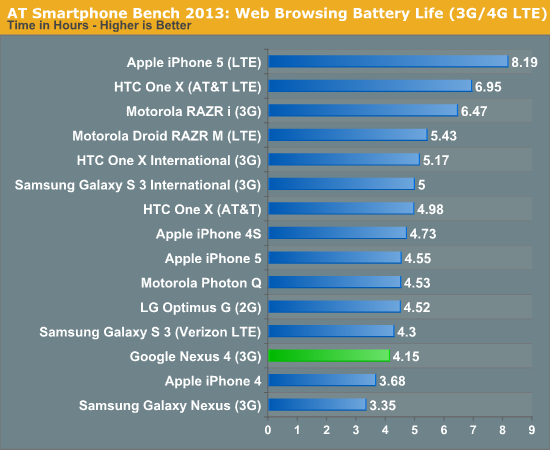
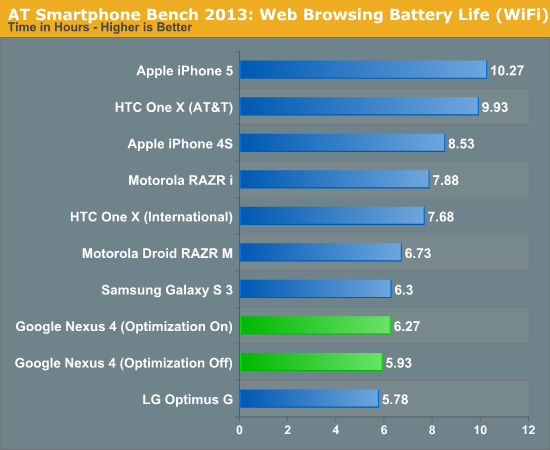
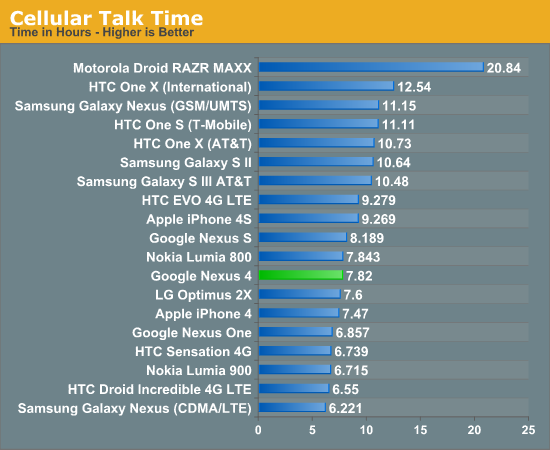
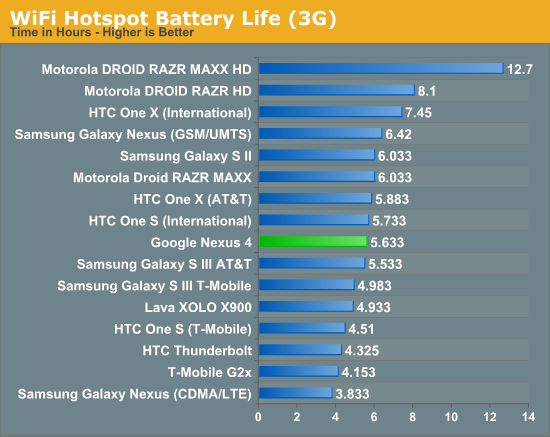
I've run and re-run the battery life tests on the Nexus 4 and they haven't changed since our preview a whole bunch. The result is battery life that isn't really chart topping, yet in my time with the Nexus 4 I haven't really been want for more battery life at any point. I'm able to get through a single day with the device set on auto brightness.



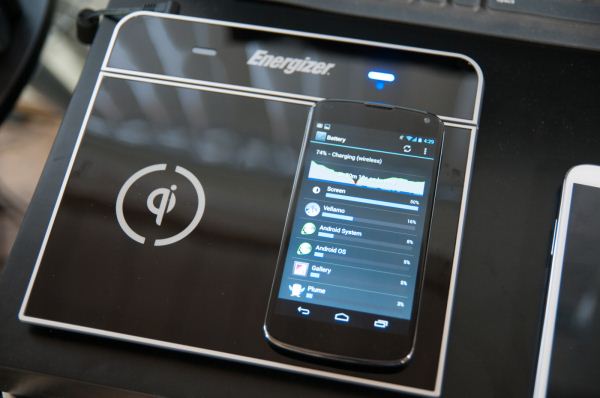

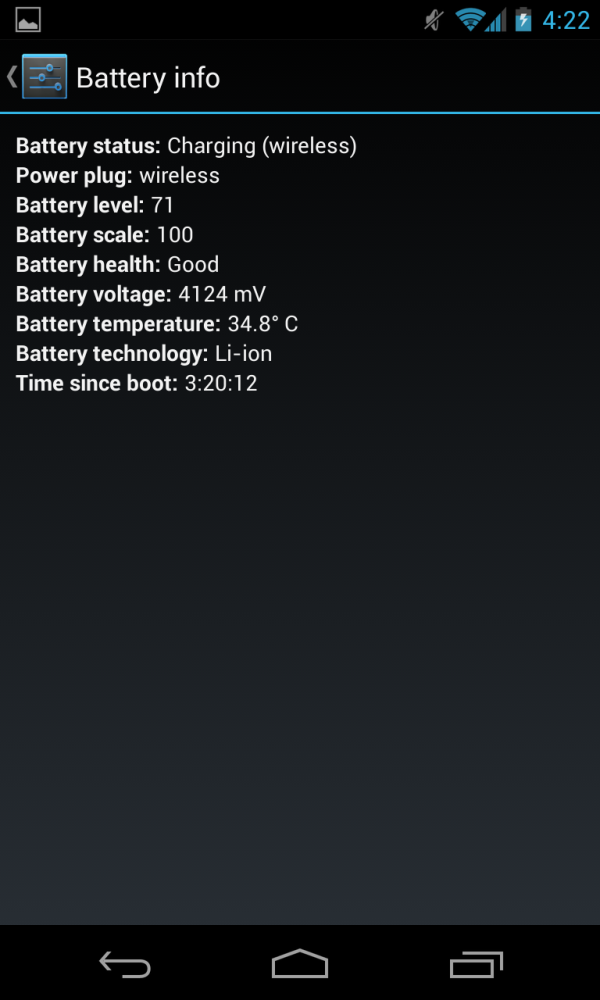








188 Comments
View All Comments
Notwist - Monday, December 10, 2012 - link
I've been married to the Apple ecosystem for the last several years, but more and more, I'm really intrigued by what Android offers, particularly with regards to how it streamlines and organizes things (the card system, displaying multiple bits of info on a single page, etc.). I have alot of trouble with organization in my life, so any systems/software/etc. that can help streamline things and act as closely to a digital assistant as possible would be very valuable to me.Also, I love the Podcasts you guys do, and was interested if you could elaborate on the whole "iOS is like an appliance, Android is a computing device" I've heard Anand mention a few times now.
Basically: as somebody already in the Apple ecosystem, but willing to change (and pretty technically inclined), what are your feelings regarding the two OSes? What would you suggest? Thanks! =)
EmilyGreen - Monday, December 24, 2012 - link
Does this phone work on AT&T's 4GLTE or not? Anyone know? I've heard different stories. As a graphic designer (in New York), I need that data speed for sending large files.Mothi - Wednesday, February 6, 2013 - link
Do Nexus 4 support Apple EarPods from apple?divinny - Wednesday, May 29, 2013 - link
it does support the earpods cause it got the same 3.5 mm see here http://www.ozphoneshop.com/nexus-4-review , but it won't support the volume buttons it is apple device featuresaddisonis19 - Wednesday, March 13, 2013 - link
hey i was just wondering i am going to try to swap my battery and was wondering if that will void the warranty i just bought. is there any security tape when you take it apart. i didnt see any but i just want to make sure.rohini - Thursday, March 28, 2013 - link
it hasn't been released in India till now! :(nidz109 - Thursday, April 4, 2013 - link
You should revisit the newest Nexus devices again. With Chrome Beta, the Nexus 10 and Nexus 4 bury the iPad, and iPhone 5 in Sunspider, Kraken, Octane, Browsermark and the RIA javascript benchmark. The Mali-T604 is behind, when it comes to GPU power, but the Adreno 320 is still very competitive. Take a look at the average GLBenchmark T-Rex HD off-screen benchmarks. Qualcomm is doing it right, and I'm patiently waiting for the S800. It's sad that Google's crappy Chrome for Android was holding everything back, but that's not the case anymore. Chrome Beta is actually awesome, and I use it more than the AOSP browser.With S800, they're going to have the SoC of the year.
vishnu_nm - Sunday, June 28, 2015 - link
Hi,Can you pls let me know the exact location of network antenna? I mean is this in the back cover or in the main body?
NB: after charging port replacement, my phone is showing no network. My back cover is a bit shattered and i wasn't too know if that is the reason or is the problem with the daughter board containing charging port.
An answer will be heavily appreciated!!